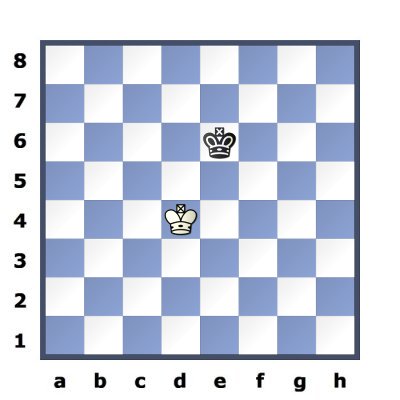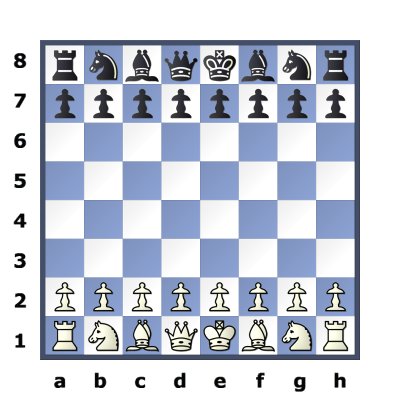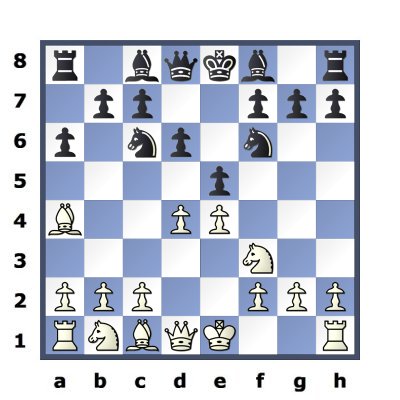Notation: how to read or record a game
Now you don't need to know all this before you join a club (you'll soon pick it up) but if you're going to read about chess - or play in competitions - you will need to understand chess notation, which is a code used to record the moves of a chess game. It is not difficult to learn but does need some explanation, so here are the details of the standard notation used nowadays.
It is called algebraic notation to distinguish it from the obsolete descriptive notation, which you may still find in older books. We won't concern ourselves with that though, as algebraic notation is nowadays universal.
The board and its squares

- The horizontal rows 1-8 are called "Ranks"
- The vertical rows a-h are called "Files"
- Squares are named by their rank and file, with the file coming
first
- The White King here is on d4
- The Black King here is on e6
- The board is generally represented from White's point of view
(i.e. White playing from the bottom up) but the names of the
squares remain the same, no matter how the diagram is aligned:
- The White King's starting square is always e1
- The Black King's starting square is always e8, even if the diagram is flipped.
The initials of the pieces

Moves are described by (i) the initial of the piece moving and (ii) the square it lands on. In the English speaking world, the initials are:
- K = King
- Q = Queen
- R = Rook
- B = Bishop
- N = Knight (to distinguish it from K = King)
Moving the White King's Knight to f3 would be Nf3. Note that the initials of the pieces are in uppercase, and the squares in lowercase. For example Bb6 would mean that the Bishop moves to square b6.
Pawns aren't assigned an initial, and moving the e-pawn to e4 would simply be e4.
Captures, castling etc

White has a few plausible moves here, and this is how they would be recorded:
0-0 indicates Kingside castling (0-0-0 is Queenside castling)
"x" is used for captures, and it is the square of the captured piece that is recorded: not the piece itself. So if White captures the c6 Knight, it will be recorded as Bxc6.
Checks are indicated by +, so in this instance it would actually be Bxc6+.
Pawn captures record the file of the Pawn and the square moved to. For example dxe5 (for White to capture the e5 Pawn with his d-pawn).
Summary of conventions used in notation
| Symbol | Meaning | Example |
|---|---|---|
| x | Captures | Nxf6 : Knight captures the piece on f6 |
| <none> | Pawn capture | For example, "fe" (= f-pawn captures the e-pawn). Uncommon now. |
| ! | Good move | 11. Qe6! : White played a good 11th move |
| !! | Brilliant move | 10...Bb7!! : Black's 10th move was brilliant (ellipsis denotes a move by Black) |
| ? | Poor move | 11. Qe6? |
| ?? | Blunder | 11. Qc7?? |
| !? | Clever, if not 100% | 20. Nxh7!? : Ingenious try - but against best defence? Might not work. |
| ?! | Doubtful but trappy | 15...Nxf3?! : Technically unsound - but may trick / bluff many players |
| 0-0 | Castles Kingside | . |
| 0-0-0 | Castles Queenside | . |
| + | Check | 20. Qf6+ : White moves his Queen to f6, delivering check |
| # | Mate | 20...Qxh2# : Black captures the piece on h2, delivering mate |
| ++ | Mate | Another way of denoting mate |
| ep | En passant | 14. fxe6 ep : White captures the e5 (sic) pawn en passant. Not used much now |
| =Q etc | Promotion | 20. e8=Q. Pawn goes to e8 promoting to a Queen. Or simply 20. e8Q |
D W Bogle: 01 Sep 2024